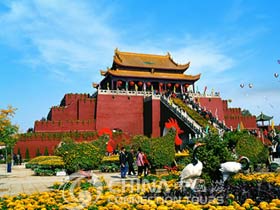
 This splendid building in the northwest corner of the city was originally the site of the imperial palace of the Northern Song Dynasty, formerly called Longevity Pavilion. The present building was reconstructed, covered with golden glazed tiles and has graceful upturned eaves in 1692 in the 31th year of the reign of Qing Emperor Kangxi. The Great Hall was on a 13-meter-high brick platform. The stone way is composed of three staircases with 72 steps. On a slanting stone halfway up the seventy-two steps which lead to a raised platform in front of the building, there are some vague horseshoe outlines among the carved dragon patterns. According to an old legend, the horseshoe prints were left by Emperor Tai Zu, Zhao Kuangyin (727-976), of the Song Dynasty when he rode up the steps on horseback. In the middle of the stone way is a blue-stone ramp with dragons carved on it. In front of the pavilion are Pan and Yang's Lakes. The pavilion goes straight to Yu jie. In the reconstructed east and west side halls is China's first wax figure museum where historical stories of the Northern Song period are represented. Inside the pavilion are enshrined the emperor's tablets. Two dragons playing with a pearl are carved on a plaque on the pavilion, hence the name, Dragon Pavilion. It became an important place for local and official ceremonies and festivities.
This splendid building in the northwest corner of the city was originally the site of the imperial palace of the Northern Song Dynasty, formerly called Longevity Pavilion. The present building was reconstructed, covered with golden glazed tiles and has graceful upturned eaves in 1692 in the 31th year of the reign of Qing Emperor Kangxi. The Great Hall was on a 13-meter-high brick platform. The stone way is composed of three staircases with 72 steps. On a slanting stone halfway up the seventy-two steps which lead to a raised platform in front of the building, there are some vague horseshoe outlines among the carved dragon patterns. According to an old legend, the horseshoe prints were left by Emperor Tai Zu, Zhao Kuangyin (727-976), of the Song Dynasty when he rode up the steps on horseback. In the middle of the stone way is a blue-stone ramp with dragons carved on it. In front of the pavilion are Pan and Yang's Lakes. The pavilion goes straight to Yu jie. In the reconstructed east and west side halls is China's first wax figure museum where historical stories of the Northern Song period are represented. Inside the pavilion are enshrined the emperor's tablets. Two dragons playing with a pearl are carved on a plaque on the pavilion, hence the name, Dragon Pavilion. It became an important place for local and official ceremonies and festivities.

